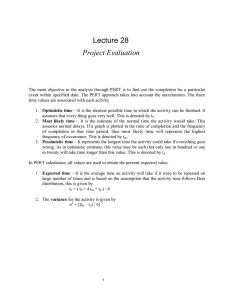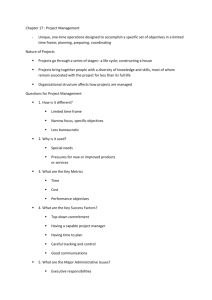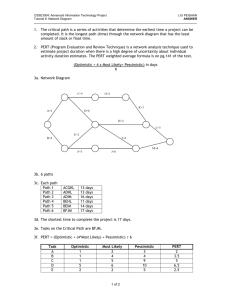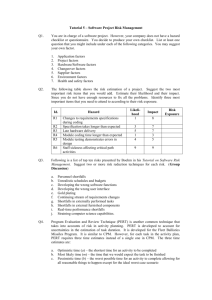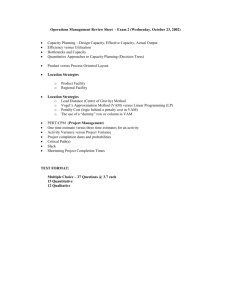PROJECT CONTROL WITH PERT/CPM
advertisement
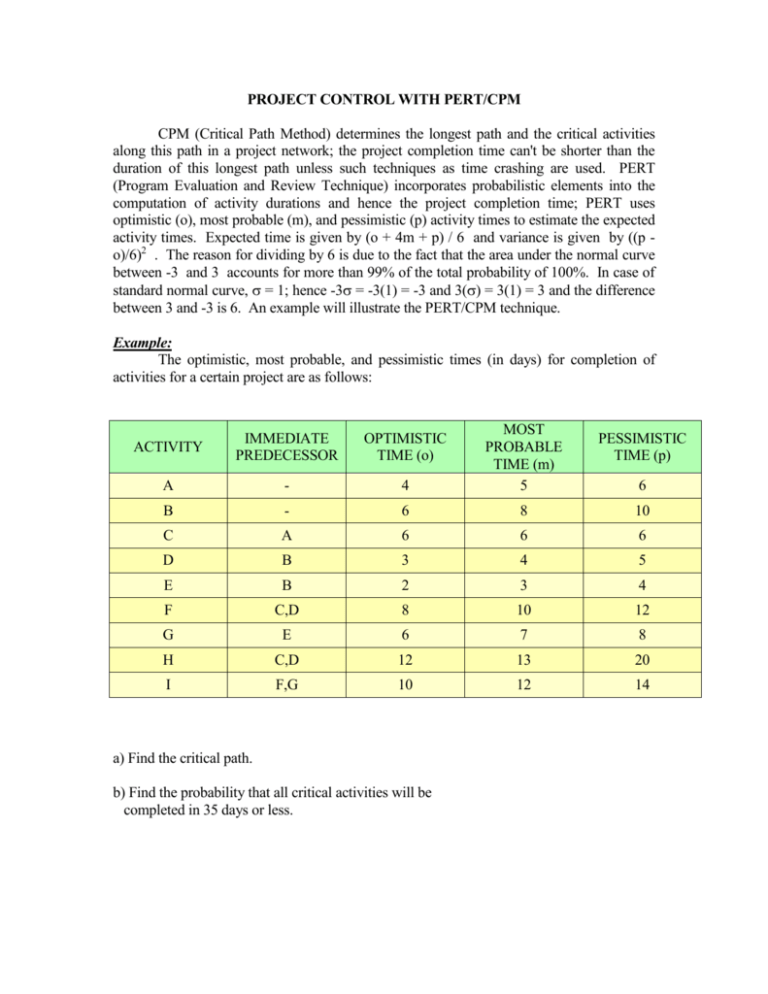
PROJECT CONTROL WITH PERT/CPM CPM (Critical Path Method) determines the longest path and the critical activities along this path in a project network; the project completion time can't be shorter than the duration of this longest path unless such techniques as time crashing are used. PERT (Program Evaluation and Review Technique) incorporates probabilistic elements into the computation of activity durations and hence the project completion time; PERT uses optimistic (o), most probable (m), and pessimistic (p) activity times to estimate the expected activity times. Expected time is given by (o + 4m + p) / 6 and variance is given by ((p o)/6)2 . The reason for dividing by 6 is due to the fact that the area under the normal curve between -3 and 3 accounts for more than 99% of the total probability of 100%. In case of standard normal curve, = 1; hence -3 = -3(1) = -3 and 3() = 3(1) = 3 and the difference between 3 and -3 is 6. An example will illustrate the PERT/CPM technique. Example: The optimistic, most probable, and pessimistic times (in days) for completion of activities for a certain project are as follows: ACTIVITY IMMEDIATE PREDECESSOR OPTIMISTIC TIME (o) A - 4 MOST PROBABLE TIME (m) 5 B - 6 8 10 C A 6 6 6 D B 3 4 5 E B 2 3 4 F C,D 8 10 12 G E 6 7 8 H C,D 12 13 20 I F,G 10 12 14 a) Find the critical path. b) Find the probability that all critical activities will be completed in 35 days or less. PESSIMISTIC TIME (p) 6 Solution: a) The expected times are obtained by using the formula (o + 4m + p) / 6 and the 2 variances are obtained by using the formula ((p-o)/6) and are summarized in the following table: EXPECTED TIME 5 8 6 4 3 10 7 14 12 ACTIVITY A B C D E F G H I VARIANCE .11 .44 0 .11 .11 .44 .11 1.78 .44 The project network diagram based on the expected values in the table above is depicted below: C ES EF 6 14 7 6,12 20,34 4 0,5 12,26 H 4 2 5 5,11 F 12 22,34 22,34 1,6 12,22 12,22 A 8,12 LS LF 8,12 10 1 B 6 0,8 0,8 7 11,18 G 15,22 D 8 3 E 8,11 12,15 3 5 I The numbers in brackets above the arrows show the earliest start (ES) and earliest finish (EF) for each activity respectively whereas the numbers in brackets below the arrows show the latest start (LS) and latest finish (LF) times respectively. EF = ES + activity duration and LF = LS + activity duration Activity slack = LS - ES = LF - EF. Activity slack shows how much an activity can be delayed without affecting the project completion time. For example, in our problem slack for activity E = 12 - 8 = 4 ; hence we can delay activity E for 4 days and still finish the project in the expected completion time of 34 days. On the other hand, when the activity slack is zero, that activity can be delayed zero days, meaning that it can't be delayed; hence an activity is critical whenever its slack is zero. Such an activity is called critical because any delay in the completion of that activity would delay the whole project. In our example, activities B, D, F and I have zero slack; hence they are critical activities. All other activities in our example are non critical. Knowing which activities are critical and which are non critical may be quite useful; whenever there is an unexpected delay in critical activities we can shift resources like capital, manpower, etc. from non critical activities that can be delayed to the critical activities which can't be delayed. In our problem, the critical path can be depicted as follows: Critical path: B D F I or 1 3 4 6 7 Expected completion time, = 34 days. Variance along the critical path: 2 = 2B + 2D + 2F + 2I = .44 + .11 + .44 + .44 = 1.43 = 1.43 = 1.2 b) P(x ≤ 35) = P(z ≤ (35 - 34)/1.2) = P(z ≤ 0 .83) = 0.7967 ≤ 0 .8 = 80% NOTE: z = (x-) / for standard normal distribution. In our problem x = 35, = 34 and = 1.2 and that is how we get P(z ≤ (35 - 34)/1.2) above. PERT/CPM also gives managers a pretty good idea about the probability of completing the projects so that they can plan ahead to expedite certain activities if necessary. Also, these probability computations help managers to select and accept those projects that have higher chances of completion within a specified time frame.





